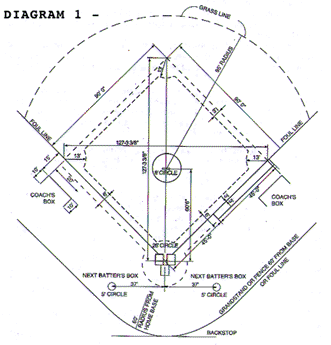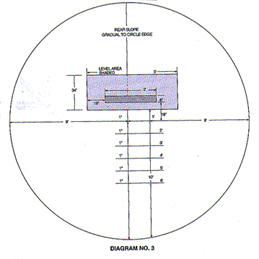Baseball Field Layout
By:

1.04
THE PLAYING FIELD.The field shall be laid out according to the instructions below. The infield
shall be a 90-foot square. The outfield shall be the area between two foul
lines formed by extending two sides of the square, as in Diagram 1. The
distance from home base to the nearest fence, stand or other obstruction on
fair territory shall be 250 feet or more. A distance of 320 feet or more along
the foul lines, and 400 feet or more to center field is preferable. The infield
shall be graded so that the base lines and home plate are level. The pitcher's
plate shall be 10 inches above the level of home plate. The degree of slope
from a point 6 inches in front of the pitcher's plate to a point 6 feet toward
home plate shall be 1 inch to 1 foot, and such degree of slope shall be
uniform. The infield and outfield, including the boundary lines, are fair
territory and all other area is foul territory. It is desirable that the line
from home base through the pitchers plate to second base shall run East
Northeast. It is recommended that the distance from home base to the backstop,
and from the base lines to the nearest fence, stand or other obstruction on
foul territory shall be 60 feet or more. See Diagram 1. When location of home
base is determined, with a steel tape measure 127 feet, 3 3/8 inches in desired
direction to establish second base. From home base, measure 90 feet toward
first base; from second base, measure 90 feet toward first base; the
intersection of these lines establishes first base. From home base, measure 90
feet toward third base; from second base, measure 90 feet toward third base;
the intersection of these lines establishes third base. The distance between
first base and third base is 127 feet, 3 3/8 inches. All measurements from home
base shall be taken from the point where the first and third base lines
intersect. The catcher's box, the batters' boxes, the coaches' boxes, the three
foot first base lines and the next batter's boxes shall be laid out as shown in
Diagrams 1 and 2. The foul lines and all other playing lines indicated in the
diagrams by solid black lines shall be marked with wet, unslaked lime, chalk or
other white material. The grass lines and dimensions shown on the diagrams are
those used in many fields, but they are not mandatory and each club shall
determine the size and shape of the grassed and bare areas of its playing
field. NOTE (a) Any Playing Field constructed by a professional club after June
1, 1958, shall provide a minimum distance of 325 feet from home base to the
nearest fence, stand or other obstruction on the right and left field foul
lines, and a minimum distance of 400 feet to the center field fence. (b) No
existing playing field shall be remodeled after June 1, 1958, in such manner as
to reduce the distance from home base to the foul poles and to the center field
fence below the minimum specified in paragraph (a) above.
1.05
Home
base shall be marked by a five-sided slab of whitened rubber. It shall be a 17
inch square with two of the corners removed so that one edge is 17 inches long,
two adjacent sides are 8 1/2 inches and the remaining two sides are 12 inches
and set at an angle to make a point. It shall be set in the ground with the
point at the intersection of the lines extending from home base to first base
and to third base; with the 17 inch edge facing the pitcher's plate, and the
two 12 inch edges coinciding with the first and third base lines. The top edges
of home base shall be beveled and the base shall be fixed in the ground level
with the ground surface.
1.06
First,
second and third bases shall be marked by white canvas bags, securely attached
to the ground as indicated in Diagram 2. The first and third base bags shall be
entirely within the infield. The second base bag shall be centered on second
base. The bags shall be 15 inches square, not less than three nor more than
five inches thick, and filled with soft material.
1.07
The
pitcher's plate shall be a rectangular slab of whitened rubber, 24 inches by 6
inches. It shall be set in the ground as shown in Diagrams 1 and 2, so that the
distance between the pitcher's plate and home base (the rear point of home
plate) shall be 60 feet, 6 inches.
1.08
The
home club shall furnish players' benches, one each for the home and visiting
teams. Such benches shall not be less than twenty-five feet from the base
lines. They shall be roofed and shall be enclosed at the back and ends.

1.09
The ball shall be a sphere formed by yarn wound around a small core of cork, rubber or similar material, covered with two stripes of white horsehide or cowhide, tightly stitched together. It shall weigh not less than five nor more than 5 1/4 ounces avoirdupois and measure not less than nine nor more than 9 1/4 inches in circumference.
1.10
(a) The bat shall be a smooth, round stick not more than 2 3/4 inches in diameter at the thickest part and not more than 42 inches in length. The bat shall be one piece of solid wood. NOTE: No laminated or experimental bats shall be used in a professional game (either championship season or exhibition games) until the manufacturer has secured approval from the Rules Committee of his design and methods of manufacture. (b) Cupped Bats. An indentation in the end of the bat up to one inch in depth is permitted and may be no wider than two inches and no less than one inch in diameter. The indentation must be curved with no foreign substance added. (c) The bat handle, for not more than 18 inches from its end, may be covered or treated with any material or substance to improve the grip. Any such material or substance, which extends past the 18 inch limitation, shall cause the bat to be removed from the game.
NOTE: If the umpire discovers that the bat does not conform to (c) above until a time during or after which the bat has been used in play, it shall not be grounds for declaring the batter out, or ejected from the game. (d) No colored bat may be used in a professional game unless approved by the Rules Committee.